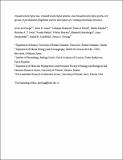Por favor, use este identificador para citar o enlazar a este item:
http://hdl.handle.net/10261/158883COMPARTIR / EXPORTAR:
 SHARE SHARE
 CORE
BASE CORE
BASE
|
|
| Visualizar otros formatos: MARC | Dublin Core | RDF | ORE | MODS | METS | DIDL | DATACITE | |

| Título: | Pseudotrichonympha leei, Pseudotrichonympha lifesoni, and Pseudotrichonympha pearti, new species of parabasalian flagellates and the description of a rotating subcellular structure |
Autor: | Campo, Javier del CSIC ORCID; Keeling, Patrick J. | Fecha de publicación: | nov-2017 | Editor: | Nature Publishing Group | Citación: | Scientific Reports 7: 16349 (2017) | Resumen: | Pseudotrichonympha is a large and structurally complex genus of parabasalian protists that play a key role in the digestion of lignocellulose in the termite hindgut. Like many termite symbionts, it has a conspicuous body plan that makes genus-level identification relatively easy, but species-level diversity of Pseudotrichonympha is understudied. Molecular surveys have suggested the diversity is much greater than the current number of described species, and that many “species” described in multiple hosts are in fact different, but gene sequences from formally described species remain a rarity. Here we describe three new species from Coptotermes and Prorhinotermes hosts, including small subunit ribosomal RNA (SSU rRNA) sequences from single cells. Based on host identification by morphology and DNA barcoding, as well as the morphology and phylogenetic position of each symbiont, all three represent new Pseudotrichonympha species: P. leei, P. lifesoni, and P. pearti. Pseudotrichonympha leei and P. lifesoni, both from Coptotermes, are closely related to other Coptotermes symbionts including the type species, P. hertwigi. Pseudotrichonympha pearti is the outlier of the trio, more distantly related to P. leei and P. lifesoni than they are to one another, and contains unique features, including an unusual rotating intracellular structure of unknown function | Descripción: | Campo, Javier del ... et al.-- 8 pages, 4 figures, supplementary material https://doi.org/10.1038/s41598-017-16259-8, supplementary video https://static-content.springer.com/esm/art%3A10.1038%2Fs41598-017-16259-8/MediaObjects/41598_2017_16259_MOESM2_ESM.mov | Versión del editor: | https://doi.org/10.1038/s41598-017-16259-8 | URI: | http://hdl.handle.net/10261/158883 | DOI: | 10.1038/s41598-017-16259-8 | Identificadores: | doi: 10.1038/s41598-017-16259-8 issn: 2045-2322 e-issn: 2045-2322 |
| Aparece en las colecciones: | (ICM) Artículos |
Ficheros en este ítem:
| Fichero | Descripción | Tamaño | Formato | |
|---|---|---|---|---|
| del_Campo_et_al_2017.pdf | 1,28 MB | Adobe PDF |  Visualizar/Abrir | |
| del_Campo_et_al_2017_suppl_1.pdf | 982,84 kB | Adobe PDF |  Visualizar/Abrir |
CORE Recommender
SCOPUSTM
Citations
9
checked on 18-abr-2024
WEB OF SCIENCETM
Citations
5
checked on 24-feb-2024
Page view(s)
338
checked on 23-abr-2024
Download(s)
346
checked on 23-abr-2024
Google ScholarTM
Check
Altmetric
Altmetric
Este item está licenciado bajo una Licencia Creative Commons

